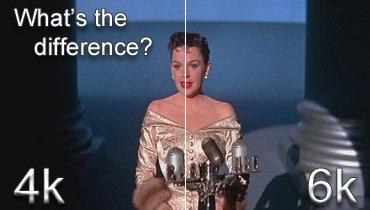The Truth About 6K

[Note: After we posted this story, Warner Bros. contacted us to give comment. (As we note in the story, we had made numerous attempts to interview someone from the studio before the story went live.) Skip past the end of the article to read a response from Ned Price, VP Mastering, Warner Bros. Technical Perations.]
On the frontier that is digital cinema, Sony is now presenting its latest blockbuster, Hancock, at selected theaters in state-of-the-art 4K resolution. If 4K is good, 6K must be better, right?
Not so fast, disheveled superhero. Warner Brothers recently announced they're transferring A Star Is Born to digital video at 6K resolution, and will eventually release it on Blu-ray Disc and DVD - though, of course, at those formats' maximum resolutions, 1080p and 480i, respectively. We just gotta ask: Why?
Aside from the fact that there are a few movie titles we'd like to see restored to best possible quality before Star, there's this more pressing issue: Is 6K an appreciable improvement over 4K, which is thought to capture every detail available on film? Will anything be gained, besides notoriety?
The 1954 version of A Star Is Born is certainly a bona fide Hollywood classic, worthy of a red-carpet redux. Starring Judy Garland and James Mason as Hollywood celebrities crossing paths - one quickly ascending to stardom, and the other quickly sinking into alcoholic oblivion - this was the third (but not last) version of this timeless tale. Warner Bros. is restoring and preserving this classic, bringing it back to its original luster. But are they going too far?
Warner has decided to treat A Star is Born to an extreme makeover. Namely, a 6K-resolution transfer - a big leap beyond the 2K and 4K resolution standards commonly used. This is a massive undertaking, and the restoration will take months to complete. A Star is Born in its original edit ran about 190 minutes. The final product will be an impressive piece of data; 1 hour of film resolved to 6K requires about 10.5 Terabytes of storage. Try to do the math. And if your calculator can't handle numbers that big, think how hard the project will be on the computers over at the W.B.
"The higher the resolution, the higher the through-put, the more onerous to move data," notes The Film Preserve's Robert Harris - who has worked on many modern restorations, including The Godfather, Lawrence of Arabia, and My Fair Lady. Harris says 6K is unwieldy to manipulate in post-production. "Moving data in 4K is horrific. It's four times as much data as 2K." Consequently, Harris speculates that the 6K scan will be down-converted to 4K.
So is it worth it?
"A 6K transfer is just an attempt at marketing position," declares Lowry Digital Images' Chief Technical Officer John Lowry, who's done high-definition and 4K transfers on some of Hollywood's greatest films, including, Citizen Kane, Snow White and the Seven Dwarfs, a number of James Bond movies, and the Indiana Jones and Star Wars collections. "Everything on film is captured at 4K, down to the film grain. In fact, if there is any motion, there's even less resolution than 4K. If the camera pans, there's less than 4K. The bottom line is this measurement of resolution is fragile. Any movement, and you're probably at 2 or 3K in terms of actual resolution due to the blurring caused by camera shutter limitations (similar to how movement causes a blurry image when you're shooting a still frame picture). Even slight camera pans and tilts will cause this. If you're gonna talk about 6K, why not 8K, or 10K? At some point, it just becomes ridiculous. Bottom line: 4K is pretty darn good."




























































